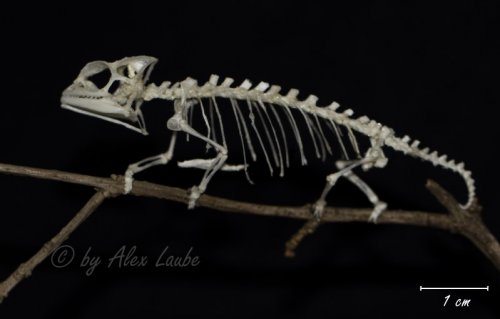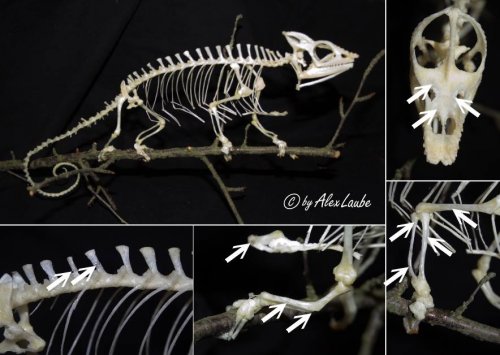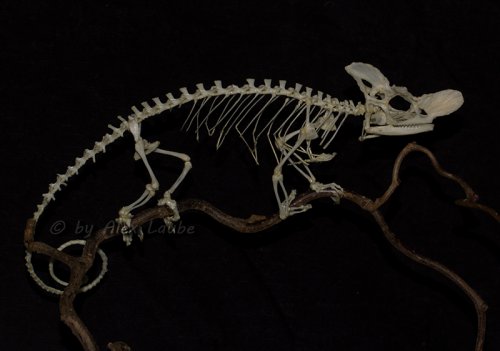Navigation
Install the app
How to install the app on iOS
Follow along with the video below to see how to install our site as a web app on your home screen.
Note: This feature may not be available in some browsers.
More options
You are using an out of date browser. It may not display this or other websites correctly.
You should upgrade or use an alternative browser.
You should upgrade or use an alternative browser.
Chameleon skeletons
- Thread starter Alexl
- Start date
Alexl
Avid Member
Just want to show a "normal" skeleton among numerous captive kept chameleons. It's a Furcifer pardalis male. He's a typical one with calcium deficiency: Thin, partially "translucent" bones, a whole in the breast bone, thin bones at the head...
Unfortunately, nothing of these problems could be seen in the animal when alive. It looked - beside the bowed arm, which was a residue of a fracture at very young age - completely normal to the owner. His whole life time, this chameleon was given serveral vitamin and calcium supplements, but not on a really regular basis. He got UVB by different kind of bulbs, but none of them was measured. Supplementing and lightning was done this way "because he always looked fine".
Well, please stop thinking "looking fine" on the outside means everything's well inside, too (compare to my prepared metabolic bone disease chameleon some pages before). Since I found many dissected chameleons have exactly the same problems, I'm pretty sure there are many captive kept chameleons suffering of calcium deficiency without the owner noticing it. It's so important to always have sufficient UVB lightning and proper supplements. Of cause, the animal here didn't have obvious problems. He ate and drank normally, he moved normally. But he surely had at least an immunodeficiency, which made him more prone to any kind of diseases. Nevertheless he became 4 years old, but I think it could have been more if kept under better UVB and vitamin conditions.
Unfortunately, nothing of these problems could be seen in the animal when alive. It looked - beside the bowed arm, which was a residue of a fracture at very young age - completely normal to the owner. His whole life time, this chameleon was given serveral vitamin and calcium supplements, but not on a really regular basis. He got UVB by different kind of bulbs, but none of them was measured. Supplementing and lightning was done this way "because he always looked fine".
Well, please stop thinking "looking fine" on the outside means everything's well inside, too (compare to my prepared metabolic bone disease chameleon some pages before). Since I found many dissected chameleons have exactly the same problems, I'm pretty sure there are many captive kept chameleons suffering of calcium deficiency without the owner noticing it. It's so important to always have sufficient UVB lightning and proper supplements. Of cause, the animal here didn't have obvious problems. He ate and drank normally, he moved normally. But he surely had at least an immunodeficiency, which made him more prone to any kind of diseases. Nevertheless he became 4 years old, but I think it could have been more if kept under better UVB and vitamin conditions.
Attachments
Last edited:
Alexl
Avid Member
More than one year ago since I've posted the last picture. This is an older skeleton, but I still like it very much. A Kinyongia xenorhina male, note the strange nose appendage this species has. It looks like two flat nose appendages glued together.
Attachments
wodesorel
Established Member
I wanted to say thank you for posting the MBD comparison a few pages (and years) back. I've been reading up and looking at xrays, but actually seeing the underlying bones and the physical changes that occurred made it 'click' immediately and now I can see what others have talked about on my new rescue. It also helped my husband have a better understanding of the severity of the condition since he is not familiar with reptiles.
Your attention to detail and your patience is amazing. You must have extremely steady hands!
Your attention to detail and your patience is amazing. You must have extremely steady hands!
Alexl
Avid Member
It has been a long while since I've posted the last skeleton, so here's one from the time inbetween. It's a large Calumma parsonii parsonii male. Sadly, he died at the age of two or three years due to a massive gout (probably caused by overfeeding). Remember... It's not size that matters but health.
Attachments
Hashtag ChamLife
Avid Member
@Alexl
I want to say thank you for these. You do great work! It's very interesting to me, even if I'm not a scientist of any kind. It's amazing to see all the tiny bits that make our "pets" so magical. My first panther girl had MBD and I've been able to get her healthier... I'm curious as to what she looks like on skeletal level. I have gone back through here and checked out the MBD models (and all the rest). Very informative.
I appreciate your hard work, Thanks!
I want to say thank you for these. You do great work! It's very interesting to me, even if I'm not a scientist of any kind. It's amazing to see all the tiny bits that make our "pets" so magical. My first panther girl had MBD and I've been able to get her healthier... I'm curious as to what she looks like on skeletal level. I have gone back through here and checked out the MBD models (and all the rest). Very informative.
I appreciate your hard work, Thanks!
Thatwizard420
Chameleon Enthusiast
are the teeth part of their skeleton?It has been a long while since I've posted the last skeleton, so here's one from the time inbetween. It's a large Calumma parsonii parsonii male. Sadly, he died at the age of two or three years due to a massive gout (probably caused by overfeeding). Remember... It's not size that matters but health.
Alexl
Avid Member
Is there a way to reference the size
Yes! I built in a scale. But it's a bit difficult because the skeleton wasn't photographed exactly from the side, but a little bit sloped. For a better idea: The orbit is about 2 cm wide.
I'm glad you like it!
are the teeth part of their skeleton?
Yes. Chameleons' teeth are acrodont, i.e. the teeth sit vertically on the jawbone and are part of it. There is no separation in alveolus and teeth as in dogs and cats. Look at this graphic, it explains the different types of dentition.
Attachments
jamest0o0
Chameleon Enthusiast
if you dont mind me asking where did you get so many cham skeletons? hopefully they wherent used in the name of "art" like what Katinka Simonse (sicko...) does....
they are very interesting..should be in museams! never seen so many chameleon skeletons, i turned my computer away from my lil guys!!
Well, i learned who this lunatic katina whatever is... shouldn't have looked it up. And I'm sure there's a feminist out there defending this less than human smh.
JoXie411
Chameleon Enthusiast
Wow why you hating on tinkerbell? Jk I looked her up and wow I thought I was weird and disturbed but that women takes the cake.Well, i learned who this lunatic katina whatever is... shouldn't have looked it up. And I'm sure there's a feminist out there defending this less than human smh.
jamest0o0
Chameleon Enthusiast
Wow why you hating on tinkerbell? Jk I looked her up and wow I thought I was weird and disturbed but that women takes the cake.
Lmao I know same!
Similar threads
- Replies
- 8
- Views
- 1K














